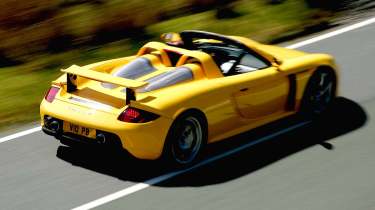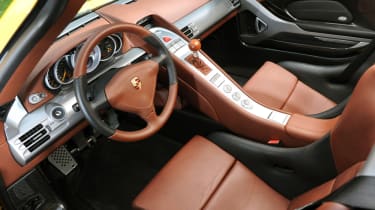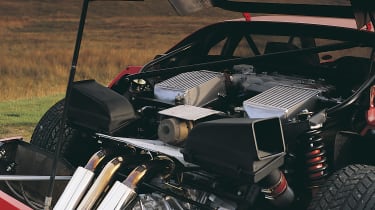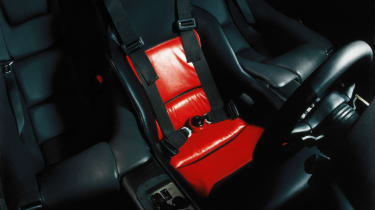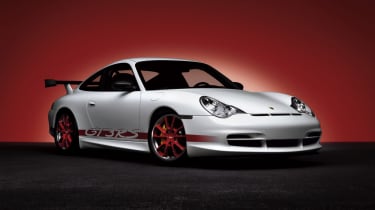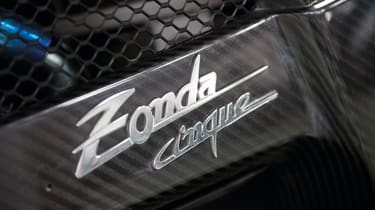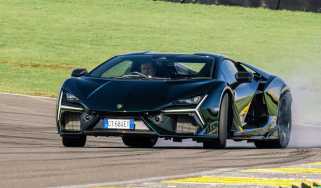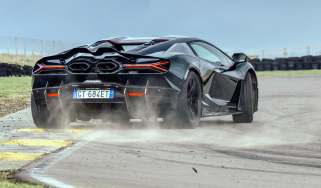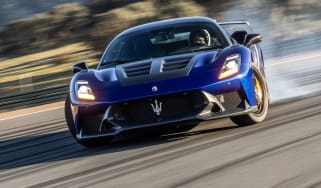What’s your favourite supercar detail?
We list evo’s favourite obscure car features from the world of exotica
At a glance, supercars appear bold, brash and loud. But look a little closer, and often you’ll notice smaller details that would otherwise go unnoticed.
Below, we explore some of our favourite obscure supercar details. Our list includes those inspired by motor racing, art and even marine life, to name a few.
Porsche Carrera GT – wooden gearknob
The Carrera GT has long been celebrated as one of the world’s greatest analogue supercars. Raw, light and super fast (thanks to a gorgeous 5.7-litre V10), it’s often labelled as a racing car for the road.
Porsche chose its then-flagship supercar to celebrate its illustrious sports car racing history. The Carrera GT’s design took more than a little influence from Porsche's 1998 Le Mans-winning 911 GT1 racing car, with the headlights and front grille clearly paying tribute.
But one of the less obvious features of the Carrera GT is its Le Mans-influenced gearknob. Early cars received a spherical beechwood gearknob, which not only contrasted the cars' aluminium interior trim, but also paid homage to the balsa wood gear levers of the legendary two-times Le Mans winning Porsche 917 endurance racers.
McLaren P1 – fish-inspired body
The McLaren P1’s bodywork is designed to work and channel air to maximise performance. Aerodynamicists had to find more than 600kg worth of downforce, while also ensuring two sets of radiators (located at both the front and rear) were fed enough cold air.
But designers weren’t just influenced by findings in computational fluid dynamics and wind tunnel testing. Because the McLaren P1’s finished shape also owes some of its design to fish.
McLaren’s boffins noticed that as a fish swam through water, water passed over, around and through it. Influence was taken from fish gills in designing the P1’s intakes, along with CFD and wind tunnel testing, ensuring the P1's status as one of the most aerodynamically complex cars to ever grace the road.
Okay, so it’s far more complicated than turning a fish into a hypercar, but it does confirm that McLaren isn’t afraid to look outside of the box. Or into a fishpond.
Ferrari F40 – two rubber fuel cells
When we think of the Ferrari F40, we might remember its achingly cool 80s exterior or savage turbocharged 2.9-litre V8. What we’re unlikely to think of are its rubber fuel tanks.
For a car that’s famed for supplying torque in one heavy lump (making it a handful to drive quickly), it’s perhaps surprising to hear that its fuel cells are made not of metal, but of rubber.
Ferrari had good reason for this setup: twin rubber tanks were lighter, good for weight distribution and essential for the car’s tight packaging. And who can argue with the results? The Ferrari F40 was, and still is, an iconic supercar with the performance to match.
McLaren F1 – Red seat trim
One of the Ferrari F40’s arch-rivals was the McLaren F1. Just like the F40, it also benefitted from several features not dissimilar to the Formula 1 racing cars from which its name originated. One of the most obvious in the McLaren was its central driving position.
While the innovative three-seat layout of the F1 is widely known, fewer people know about the drivers’ seat’s contrasting leather. As noted by Henry Catchpole in our recent McLaren F1 v P1 video, the drivers’ seat was swathed in a bright, contrasting shade in an otherwise sombre cabin.
Owners could specify their own trim choice, but whatever their requirements, the contrasting colour meant that at a glance, the McLaren F1 looked like a proper single seater - highlighting the importance of that central pew.
LaFerrari – all-electric mode
When Ferrari confirmed the specifications of the LaFerrari’s drivetrain, it omitted any mention of an all-electric mode. Unlike the Porsche 918 and McLaren P1, the LaFerrari’s electric motor was described only as a means to boost performance, and not something to cut emissions.
But since the arrival of customer cars, recordings of LaFerraris creeping about pit lanes and cities of the world in complete silence have begun to surface. As it turns out, the LaFerrari’s 160bhp electric motor can in fact be operated in isolation.
996 Porsche 911 GT3 RS – weight saving sticker
When manufacturers put their cars on a strict diet, a holistic approach to weight saving is the most effective method. Interiors are stripped, wheels are forged and in the case of the 996 Porsche 911 GT3 at least, bonnet enamel badges are ditched. What will you find in the badge’s place? A sticker.
Not only did the stickers save precious grams over the nose, they also removed the need for Porsche to drill holes into the GT3’s brittle carbonfibre bonnet. In turn, the chances of cracks appearing were substantially reduced. And on a car as focused as a 911 GT3, even the tiniest details make a difference.
Pagani Zonda - etched bolts
Every single nut and bolt in a Pagani Zonda is etched with the word Pagani. Check the Huayra's titanium nuts and bolts, and you'll find the same etching. In fact, check every single nut and bolt to be fitted to any Pagani, and you'll find the Italian supercar builder's etching.
This feature serves perfectly in defining the intricate attention to detail every Pagani creation receives. Be it the nuts and bolts, the seat stitching or carbotitanium joins, Pagani's creations could quite easily be labelled as works of art. With high-revving AMG engines producing more than 700bhp though, they're certainly supercars.
What’s your favourite obscure supercar detail? Let us know in the comments below.
